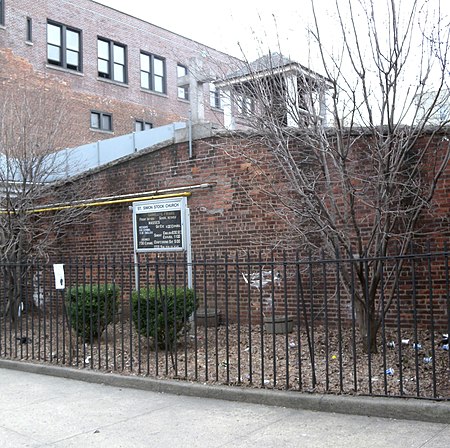The Paradise Theater (formerly the Loew's Paradise Theatre) is a theater at 2403 Grand Concourse in the Fordham neighborhood of the Bronx in New York City, United States. Designed by John Eberson as a movie palace, it opened on September 7, 1929, as one of five Loew's Wonder Theatres in the New York City area. Although the building is no longer in use as a movie theater, its facade and interior are preserved as New York City designated landmarks.
The Paradise Theater is composed of a lobby wing and a retail wing facing the Grand Concourse to the east, as well as an auditorium wing facing Creston Avenue to the west. The theater has an ornate terracotta facade on the Grand Concourse, with a multicolored Baroque–style frontispiece. The main facade originally also included a mechanical Seth Thomas clock and a sculpture of Saint George fighting a fire-breathing dragon. The other facades are simpler and made of brick. There are an outer lobby, foyer, and main lobby on the ground level, which are decorated with murals and sculptures. On the second story are a promenade, lounges, and balcony lobbies. The auditorium has 3,855 seats on two levels, with an elaborately decorated proscenium arch, walls, and ceilings. Like the other Wonder Theatres, the Paradise Theater featured a "Wonder Morton" theater pipe organ manufactured by the Robert Morton Organ Company, though the organ has since been removed.
A subsidiary of Paramount-Publix first acquired land for the theater in 1925, and Loew's Theatres took over the site in 1927. The Paradise Theater originally presented films and live shows. but the live shows were discontinued within five years of the theater's opening. The theater slowly declined after World War II, and the auditorium was subdivided three times in the 1970s and 1980s, becoming a multiplex with four screening rooms. The Paradise Theater closed in 1994 and was shuttered for over a decade. Following an unsuccessful renovation attempt led by Richard P. DeCesare, the theater was sold in 2003 to Gerald Lieblich, who completed the renovation. The theater reopened in 2005 as an event venue, and it was sold twice in the next four years. The Paradise was then leased in 2012 to the World Changers Church International New York, a local congregation, which vacated it in 2020.







